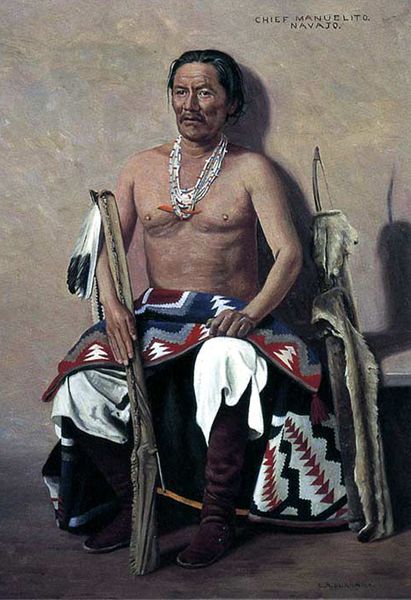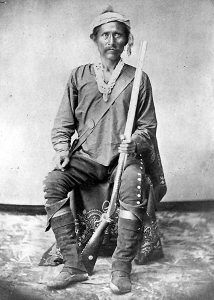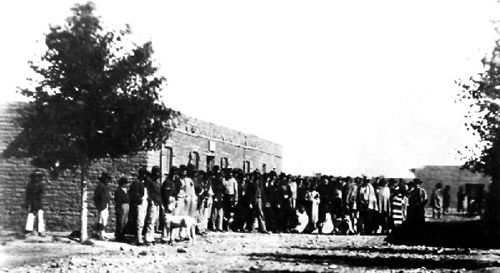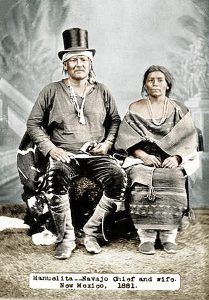A principal Navajo war chief, Manuelito, was born near Bears Ears Peak in southeastern Utah in about 1818. He was a member of the Bít’aa’níí or ″Folded Arms People Clan″ and his father, Cayetano, was a recognized leader known for his resistance to foreign invasion. His name means Little Manuel in Spanish, and non-Navajo nicknamed him “Bullet Hole.”
He later migrated to Arizona, where he joined Chief Narbona’s band and married his daughter. He admired Narbona’s fearless attitude, although his father-in-law tried to teach him the value of peace as well as war. Standing over six feet tall, Manuelito was determined to become a war leader and fought his first battle at Narbona Pass in 1835 when 1000 Mexicans from New Mexico were attacking the Navajo. Winning the battle, the Navajo gave him the name Hashkeh Naabaah, meaning ″Angry Warrior″.
In the years that followed, Manuelito led one raiding party after another, joining forces with other leaders such as Ganado Mucho and Barboncito to attack not only the hated Mexicans but also the Hopi in Arizona, the Puebloan peoples of New Mexico, the Ute, the Comanche, and the Apache.
In November 1846, he was one of 14 Navajo chiefs to sign the Bear Springs Treaty, the first of nine treaties he would sign over the years. However, the treaty didn’t end the conflict between the Navajo, the New Mexicans, and recently arrived white settlers.
By 1860 the U.S. military, Mexican-Americans, the Zuni, and the Ute tribes were raiding Navajo lands. As a result, Chiefs Manuelito and Barboncito, leading 1,000 Navajo warriors, attacked Fort Defiance, Arizona, on August 30, 1860. They nearly overran it, but superior gunfire forced a retreat. This led to the U.S. Army’s policy of “total war” against the Navajo. Colonel Edward Canby and his forces set out in early October and over the next several months killed 23 Navajo and destroyed Navajo stock and crops.
In the fall of 1862, Major General James H. Carleton was to the New Mexico Territory and made plans to subdue the Navajo and force them to a reservation called the Bosque Redondo in Fort Sumner, New Mexico. By the following year, thousands of Navajo had turned themselves in at military forts throughout New Mexico, and the year 1864 marked the beginning of the “Long Walk” to the Bosque Redondo Reservation.
Though Manuelito met with officials at Fort Defiance, he and others refused to go to Fort Sumner and instead gathered numerous Navajo and fled into the strongholds within the mountains of western New Mexico.
In 1863, U.S. forces under Kit Carson waged a full-scale campaign against the Navajo, driving the Indians from their lands by destroying their means of subsistence. His soldiers killed livestock, poisoned wells, burned crops and orchards, and destroyed Navajo buildings. After the Battle of Canyon de Chelly in January 1864, he had rounded up about 8,000 Navajo who began the Long Walk to the Bosque Redondo in March.
However, Manuelito and about 4,000 of his people were not among them. From their mountain strongholds, they waged guerrilla warfare, while Carson continued killing wild game and horses and destroying crops. By the autumn of 1866, Manuelito and his people were starving and so finally surrendered. They, too were taken to the Bosque Redondo.
During the years of confinement, Manuelito was a source of support and encouragement to his people and spent much of his time petitioning the government to allow them to return to their homeland. Conditions at the reservation were miserable, and in the spring of 1868, Manuelito and a few other leaders were permitted to go to Washington, D.C., to petition the government for a new reservation. He pleaded his cause successfully, and by that autumn, the Navajos were allowed to move to a new reservation, located in the area that had been their traditional homeland.
Once home, he was selected to be the head of tribal police. In his later years, he advocated education for his people in the hopes that they might improve their lives.
During his lifetime Manuelito is said to have had four wives, the last of whom was named Juanita.
He died in 1893 from measles complicated by pneumonia.
© Kathy Weiser-Alexander/Legends of America, updated November 2021.
Also See:
Navajo Long Walk to the Bosque Redondo
Native American Heroes & Leaders
Native Americans – First Owners of America
Sources:




